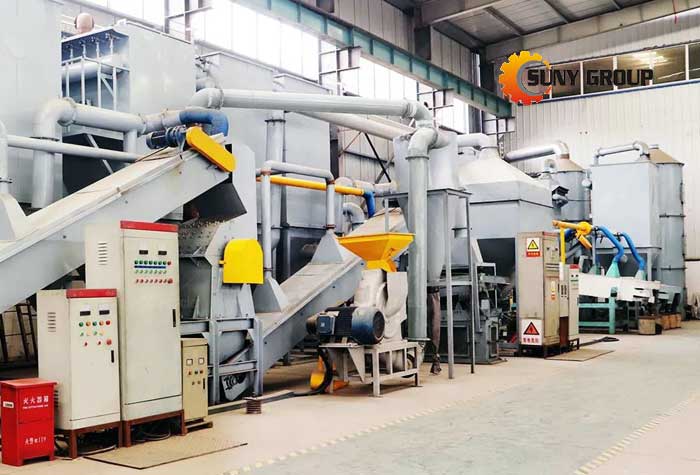The battery type is a ternary lithium battery, the specification is a 60Ah square soft pack battery, and the overall size is 208mm × 135mm × 30mm. Recycling can be done according to the following steps:
(1) The waste power lithium battery is sent to the rolling crusher through the electric conveyor belt, and the primary debris material with a particle size of 20-30mm is obtained after rolling and crushing;
(2) Start the knife crusher, the knife crusher 3 rotates at a speed of 1500 rpm, the primary debris material is sent to the knife crusher through the electric conveyor belt, and the primary debris material conveyed by the electric conveyor belt and the high-speed rotating knife The cutter head of the crusher is in contact at an angle of 60 degrees, the material is broken up and cut into secondary fragments, and the particle size of the secondary fragments is 10-15mm; Electrolyte adsorption and collection device, working under 200kPa negative pressure for 30min, realizes the recovery of electrolyte, and the recovery rate is 95%;

Lithium Battery Recycling Machine
(3) The secondary debris material enters the plastic material separation and collection device through the pipeline. After the first vibrating screen 4 disperses the secondary debris material, under the action of 200kPa vacuum negative pressure suction, the lighter plastic material is removed from other battery materials. It is adsorbed and separated, and collected into the plastic material storage silo to realize the separation of plastic material, electrode material and current collector; plastic material includes diaphragm and battery shell aluminum-plastic film mixture; the dust generated during the above-mentioned separation and collection process of plastic material is dedusted by pulse remover;
(4) The secondary debris material after separation and removal of the material is sent to the hammer mill, so that the material is deeply pulverized to obtain the tertiary debris material with a diameter of not more than 1mm; at the same time, due to the brittleness of the metal itself, copper and aluminum are collected. The fluid is pulverized into small particles, and the particle size does not exceed 1mm, so that more than 99% of the positive and negative electrode materials fall off from the current collector;
(5) The tertiary debris material is brought into the battery material separation device with the circulating air for sorting, and the cyclone 7 in the battery material separation device uniformly disperses the material at a speed of 2000 rpm. Further, the powdery positive and negative electrode materials with smaller particle size in the scattered materials are mixed with air, and then a vacuum pump is used to generate a negative pressure of 150kPa, and the middle part of the positive and negative electrode material cyclone 7 enters the cyclone through the pipeline; the first time The separation and collection rate is 90%; the current collector particle mixture with larger particle size enters the metal material storage bin through the pipeline at the bottom of the cyclone 7 under the action of gravity; the dust generated during the above battery material separation and collection process passes through the pulse dust collector. remove;
(6) The current collector particle mixture enters the second vibrating screen through the electric conveyor belt. The second vibrating screen is composed of layer screens, and the screen sizes are 18 meshes, 24 meshes and 30 meshes respectively. The mixed materials of the same mesh are shaken for 10 minutes to realize the separation of copper and aluminum particles;
(7) The positive and negative materials enter the cyclone for secondary separation and collection. The positive and negative materials are thrown at a certain height by the nozzle with an angle of 30° to the horizontal plane, and the material is parabolic with a height of 0.5-1.2m. At the same time, the cyclone 10 generates a uniform airflow field of 1.2 m/s along the vertical direction of the material parabola, and the distribution width of the airflow field is 0.3-1.5 m. During the falling process of the positive and negative electrode materials, the graphite of the negative electrode material with light specific gravity is blown away by the airflow and discharged from the upper part of the cyclone, while the positive electrode material continues to fall back and is discharged from the bottom of the cyclone 10 to realize the separation and collection of the positive and negative materials.
SUNY GROUP has rich experience in the recycling of lithium batteries and cooperates with customers all over the world. According to the needs of customers, we adopt customized lithium battery recycling solutions and equipment manufacturing. If you have related needs, please contact us.
Thank you for your interest in suny group. If you want to learn more about our E-waste recycling plant, copper wire recycling machine and other machines, Contact us now to find out what we can do for you next project!E-mail:sunymachine@gmail.com | Whatsapp:+8613674945231